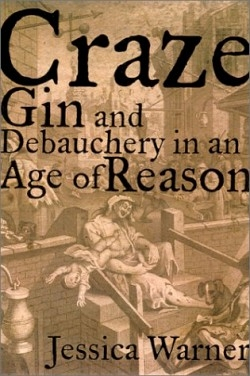Craze
Gin and Debauchery in an Age of Reason
Though the media goes to town on each new drink or drug craze as though it were unique in human history, large-scale destructive binges are nothing new, and neither is governmental response via largely unworkable and often counterproductive laws. As a disaster-of-the-day, cheap gin makes for fascinating and instructive reading.
From 1720 to 1751 (when a spontaneous decline in consumption set in) abundant cheap gin had a devastating effect on the lives of London’s poorer citizens. Though clearly recognized as producing “Whoredom, Murder, Theft / And of Rank Sedition, Treason and Blasphemy,” cheap gin defied effective or easy governmental control and management. In a model political and economic analysis, the author, a professor at the University of Toronto, explores how Parliament (largely controlled by the egregious Sir Robert Walpole) tried to control the situation while maximizing revenue-and precisely why the successive laws failed. In addition, she provides sparkling vignettes of the players—politicians, churchmen, tavern-keepers, informers, police constables, and overworked at-risk magistrates.
Warner builds her analysis on the powerful constituencies that had vested interests in gin. Big landowners (who often sat in Parliament) benefited from grain sales; distillers benefited from producing gin; the nation’s finances benefited from various licensing and taxation schemes; and in drunkenness the poor at least found temporary relief from permanent hardship. They could of course render themselves unfit for work, parenting, or military service—to their own and the nation’s detriment.
She records how Queen Caroline, frightened by in-the-street “bestialities and indecencies,” pushed for restrictive legislation (the First Lady with a good cause syndrome). Parliament passed eight “gin acts” between 1729 and 1751. They demonstrated the damaging impracticability of trying to legislate desire and morals.
In exploring the anatomy of failure, Warner shows that higher taxes on producers and tavern-keepers (the retail sellers) led sequentially to illicit street sales and, after informers were let loose and rewarded, to secret in-house sales. Attacks on informers followed, accompanied by the refusal by the rudimentary police force to rescue them or arrest denounced gin-sellers.
What lifts this narrative out of substantive history into enthralling social narrative is Warner’s crystal clear structure and her perceptive vignettes of the people. Digressions into topics such as the spontaneous combustion of alcohol-sodden individuals (a phenomenon that makes a later passing appearance in Crime and Punishment) add to interest.
This well-illustrated, well-referenced book will reward readers and, importantly, teach politicians a valuable how-not-to lesson. In all, a short book to enjoy over a long drink.
Reviewed by
Peter Skinner
Disclosure: This article is not an endorsement, but a review. The publisher of this book provided free copies of the book to have their book reviewed by a professional reviewer. No fee was paid by the publisher for this review. Foreword Reviews only recommends books that we love. Foreword Magazine, Inc. is disclosing this in accordance with the Federal Trade Commission’s 16 CFR, Part 255.

